20 Best Native Plants for Miami
BY KIMBERLY MAGERL | MARCH 20TH, 2023 | FLORIDA, LAWN CARE, MIAMIMiami is a melting pot of cultures and arts and home to over 147 parks, gardens, and recreation centers. Florida contains over 4,700 species of native plants, so it is easy to create your own diverse cultural stew in your own backyard by filling it with Florida plants.
Native plants offer many landscaping benefits, including:
- They support a diverse ecosystem, providing food and shelter for local wildlife, birds, and insects.
- They are acclimated to the tropical climate, are salt-tolerant, require less water, and are adapted to the acidic soils.
- They are low-maintenance, surviving local insects and diseases.
Native plants help promote a healthier Florida ecosystem. Check out these 20 native plants for Miami to create a diverse landscape.
In this article, we’ll cover:
- 20 Best Native Plants for Your Miami Yard
- How to Choose Native Plants for Your Miami Landscape
- FAQ About Native Miami Plants
- Where to Find Native Plants in Miami
20 Best Native Plants for Your Miami Yard
1. Beautyberry (Callicarpa americana)
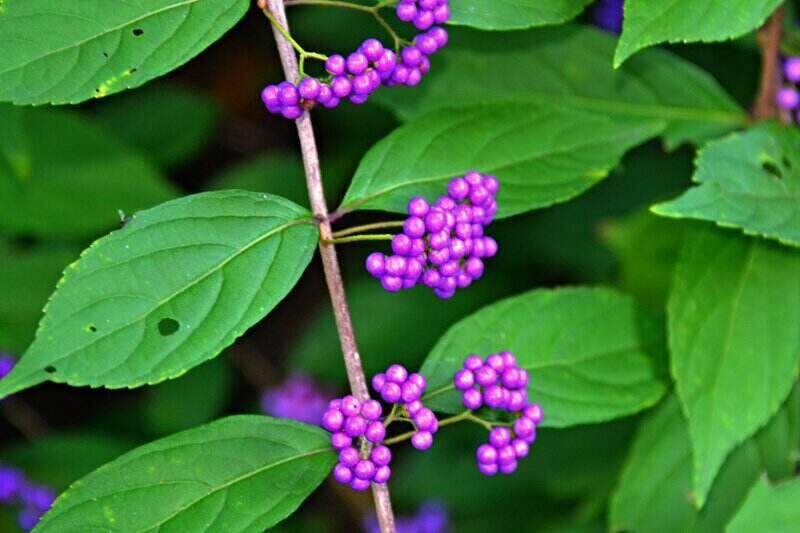
Photo Credit: Tony Alter / Flickr / CC BY 2.0
Beautyberry, also known as American mulberry, is a small shrub with bright purple fruits that attract birds and other wildlife. The sprawling shrub works well as a border plant with its long branches arching toward the ground. Some homeowners prune the plant for a more compact appearance.
Beautyberry has fuzzy, light-green leaves and small lavender flowers that bloom from spring to summer before maturing to fruits in September. The edible shrub is drought tolerant and loves rich soils, though it will adapt to the acidic, sandy soils of South Florida.
Growth habit: Shrub
USDA hardiness zone: 7-11
Mature size: 3-8 feet tall and 4-8 feet wide
Duration: Perennial
Foliage: Deciduous
Sunlight needs: Full sun to partial shade
Soil preferences: Adaptable; prefers nutrient-rich soil but tolerates acidic, sandy soil
Water needs: Drought-tolerant; prefers a regular watering schedule and moist roots
Potential hazards: Non-toxic; no safety hazards
2. Black-Eyed Susan (Rudbeckia hirta)
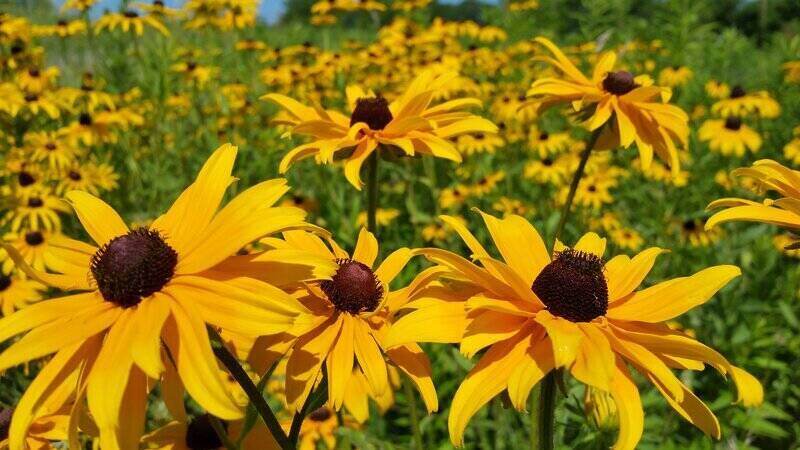
Photo Credit: Pixabay
Black-eyed Susan offers a pop of color for Miami yards. The hardy wildflower is known for its bright golden petals and dark brown center. It is salt and drought-tolerant and makes a great addition to any butterfly garden.
Black-Eyed Susan loves full sun and well-drained soil. Flowers grow atop round clumping leaves and work well as cut flowers for an outdoor-to-indoor home display.
Growth habit: Flower
USDA hardiness zone: 3-10
Mature size: 1-3 feet tall and 1-2 feet wide
Duration: Biennial
Foliage: Deciduous
Sunlight needs: Full sun
Soil preferences: Adaptable, prefers acidic soil
Water needs: Drought-tolerant; may need weekly watering during extreme dry spells
Potential hazards: Non-toxic; no safety hazards
3. Butterfly Weed (Asclepias tuberosa)
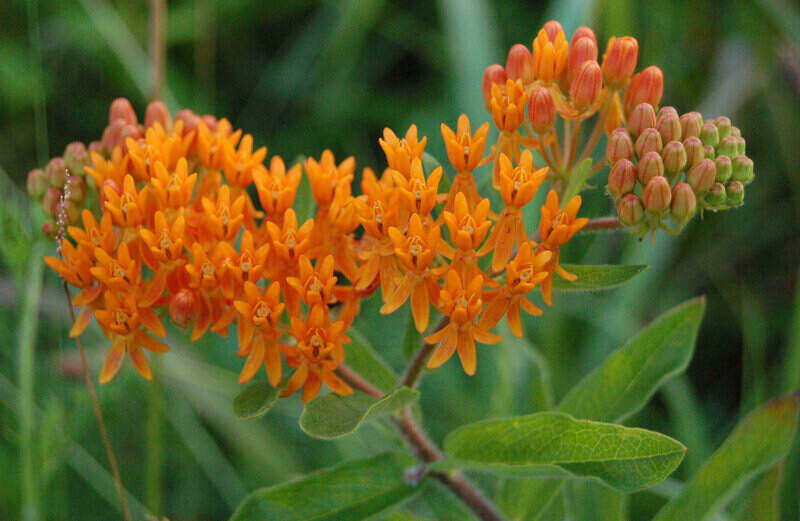
Photo Credit: Derek Ramsey / Wikimedia Commons / CC BY-SA 3.0
Butterfly weed is a native species of milkweed and is extremely important to healthy Florida landscapes. It is an attractive flowering plant and a nectar source for bees and pollinators as well as a host plant for caterpillars, including the Monarch butterfly. There are around 20 native species of milkweed that call Florida home.
Butterfly weed produces bright orange or yellow flowers from summer to fall. The attractive plant is hardy and loves full sun. It tolerates most soils and is moderately salt and drought-tolerant.
Growth habit: Flower
USDA hardiness zone: 3-10
Mature size: 1-4 feet tall and less than 1 foot wide
Duration: Perennial though some species are annuals
Foliage: N/A
Sunlight needs: Full sun
Soil preferences: Prefers dry sandy soil
Water needs: Semi drought-tolerant; prefers to dry out between waterings
Potential hazards: Low toxicity; milky sap irritates humans and animals
4. Coontie (Zamia integrifolia)
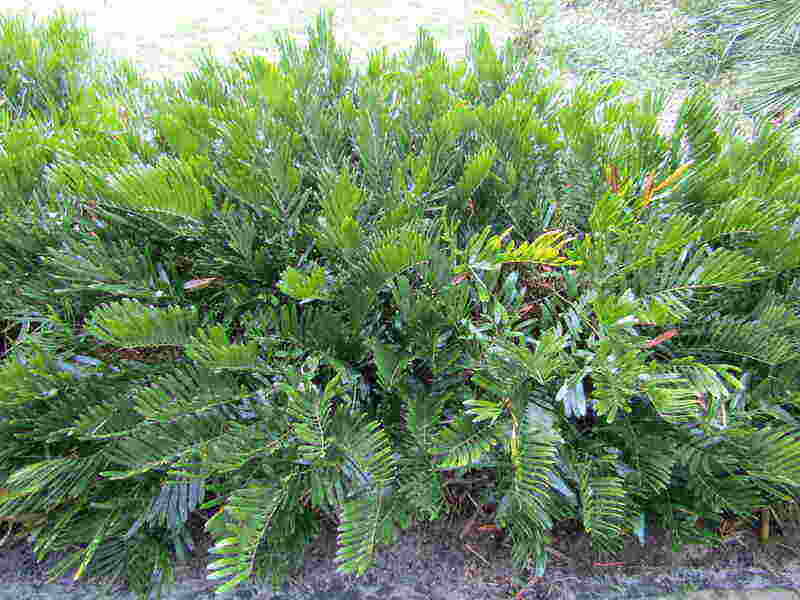
Photo Credit: Leonora (Ellie) Enking / Flickr / CC BY-SA 2.0
Coontie, also known as Florida arrowroot, is a seed plant resembling a small fern and a member of the cycad family. With ancient roots dating back to the time of the dinosaurs, this evergreen plant is the only cycad native to North America and an important member of the Florida ecosystem. It is the larval food source for the rare Atala butterfly.
Coontie has shiny, feather-shaped leaves attached to a thick stem. The round plant works well as clumping groundcover. It is drought, salt, and cold-tolerant and will thrive in sunny or shady conditions.
Growth habit: Clumping groundcover
USDA hardiness zone: 8-11
Mature size: 2-3 feet tall and 3 feet wide
Duration: Perennial
Foliage: Evergreen
Sunlight needs: Full sun, partial shade, full shade
Soil preferences: Adaptable; prefers well-drained soil
Water needs: Drought-tolerant; prefers to dry out between waterings
Potential hazards: Toxic; seeds are deadly to humans and animals if ingested, and the entire plant is poisonous
5. Coral Bean (Erythrina herbacea)
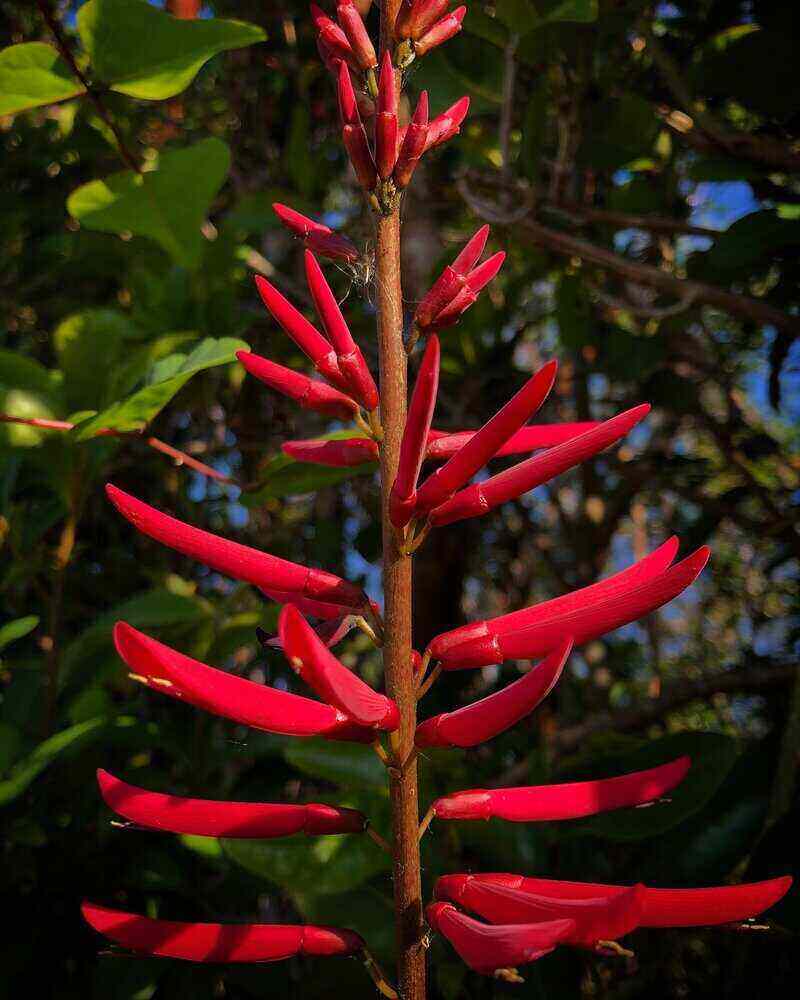
Photo Credit: Everglades National Park / Flickr / License
Like seagrape, coral bean, also known as Cherokee bean, thrives in the tropical Miami weather and grows as a large shrub or small ornamental tree. Butterflies and hummingbirds flock to the bright red tubular flowers. It grows well in natural landscapes with fertile soil, but keep in mind it is extremely poisonous to humans and animals. Coral bean performs best when planted as part of a mixed border, and the perennial shrub loses its leaves in the winter.
Growth habit: Tree or shrub
USDA hardiness zone: 8-11
Mature size: 5-15 feet tall
Duration: Perennial
Foliage: Deciduous
Sunlight needs: Full sun to partial shade
Soil preferences: Adaptable; prefers well-drained, fertile and sandy soil
Water needs: Drought-tolerant; may need weekly watering during extreme dry spells
Potential hazards: Toxic; seeds poisonous to humans and animals
6. Coral Honeysuckle (Lonicera sempervirens)
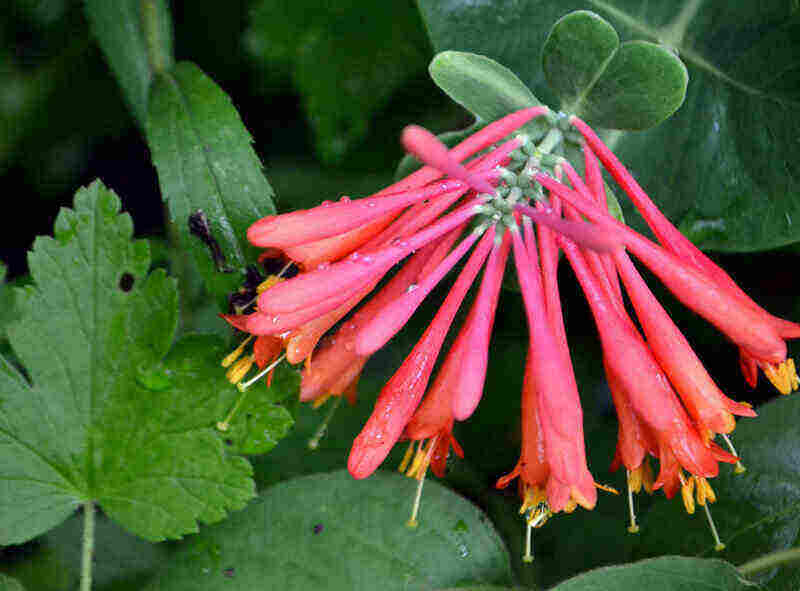
Photo Credit: Jo Naylor / Flickr / CC BY 2.0
Often found climbing the woods, sandhills, and flatwoods of Florida, coral honeysuckle is an evergreen clumping vine. It blooms year-round in South Florida and does its best blooming in the winter. You can find it crawling trellises, walls, and fences, reaching heights up to 18 feet.
The dark, shiny leaves give way to trumpet-shaped red-orange flower clusters from spring to fall, and the vine produces clusters of bright red berries from September to October. Coral honeysuckle attracts songbirds, hummingbirds, and other pollinators thanks to its vibrant flowers and fruit.
Growth habit: Vine
USDA hardiness zone: 4-10
Mature size: 3-18 feet
Duration: Perennial
Foliage: Evergreen to semi-evergreen
Sunlight needs: Full sun to partial shade
Soil preferences: Adaptable; prefers well-drained soil
Water needs: Needs about 1 inch of water per week, including rainfall (may need weekly watering during dry spells
Potential hazards: Toxic to humans and animals if ingested
7. Coreopsis (Coreopsis grandiflora)

Photo Credit: Andrey Zarkikh / Flickr / CC BY 2.0
Coreopsis, or tickseed, is Florida’s state wildflower. The perennial blooms daisy-shaped, bright yellow flowers with brown centers from spring to summer. The drought-tolerant beauties reseed themselves, attracting butterflies and native pollinators. Tickseed makes a great addition to flower beds and container gardens.
Growth habit: Flower
USDA hardiness zone: 4-11
Mature size: 1-4 feet tall and 1-2 feet wide
Duration: Perennial
Foliage: N/A
Sunlight needs: Full sun; tolerate partial shade
Soil preferences: Adaptable; prefers moist, well-drained soil
Water needs: Drought-tolerant; may need weekly watering during extreme dry spells
Potential hazards: Non-toxic, no safety hazards
8. Fakahatchee Grass (Tripsacum dactyloides)
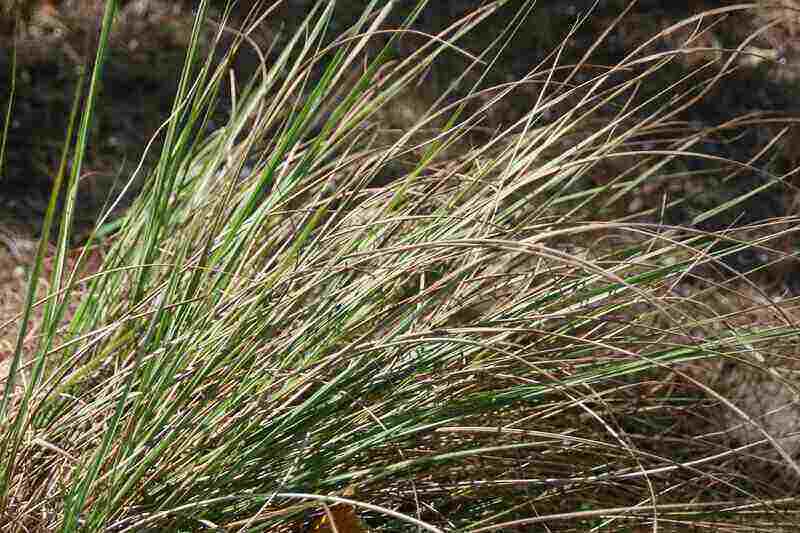
Photo Credit: David J. Stang / Wikimedia Commons / CC BY-SA 3.0
Fakahatchee grass is another great ornamental grass for Miami landscapes. It is a clumping plant, working well for accents and borders. It is the food of choice for the larval Byssus Skipper butterfly. In nature, you can find it growing along river banks and swamps.
Fakahatchee grass is easy to grow with grass-like foliage and small white flowers in late spring. It grows best in full sun and loves well-drained, moist soil, though it adapts to drier conditions and will survive flooding. It responds well to pruning but will grow just as well as a low-maintenance plant when left alone.
Growth habit: Ornamental grass
USDA hardiness zone: 8-11
Mature size: 3-4 feet tall and 4-6 feet wide
Duration: Perennial
Foliage: Evergreen to semi-evergreen
Sunlight needs: Partial shade
Soil preferences: Adaptable; well-drained, moist acidic or alkaline soil, sand, loam, clay; extended flooding
Water needs: Moderately drought-tolerant; prefers moist soil
Potential hazards: Non-toxic; no safety hazards
9. Firebush (Hamelia patens)
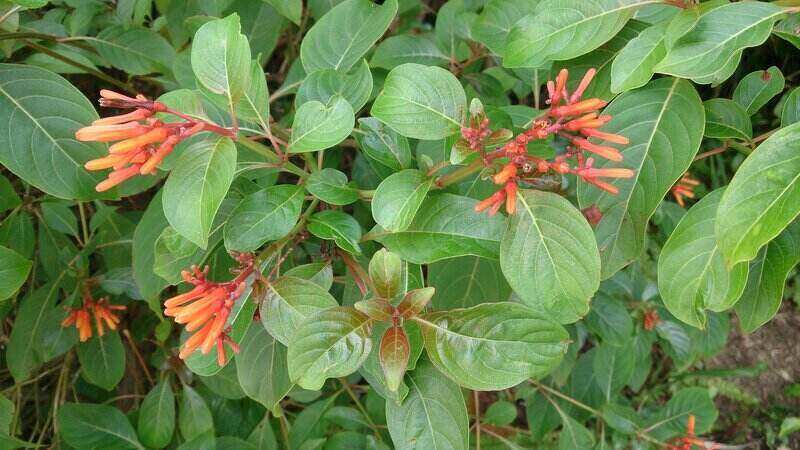
Photo Credit: Mokki / Wikimedia Commons / CC BY-SA 3.0
Firebush is a hardy shrub with bright red flowers that bloom from late spring to the first frost. Popular with hummingbirds, butterflies, and other local wildlife, the semi-woody shrub can reach up to 15 feet tall in South Florida but responds well to pruning for contained growth.
Firebush is a popular addition to many landscapes and works well as a standalone shrub, hedgerow, or border plant. The foliage will die after the first freeze but regrows in spring. It adapts to most soil conditions and is heat and drought-tolerant with no natural disease or insect threats.
Growth habit: Shrub
USDA hardiness zone: 9-12
Mature size: 6-12 feet tall and 5-8 feet wide
Duration: Perennial
Foliage: Evergreen
Sunlight needs: Full sun, partial shade, full shade
Soil preferences: Adaptable; prefers well-drained soil
Water needs: Drought-tolerant; needs about 1 inch of water per week, including rainfall (may need weekly watering during dry spells
Potential hazards: Low toxicity; poisonous to humans and animals, though it has a bitter taste most animals avoid
10. Florida Anise Tree (Illicium floridanum)
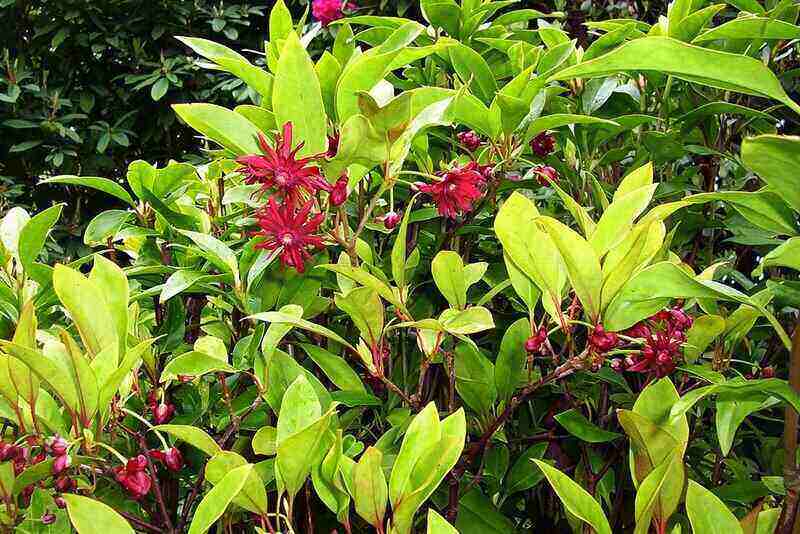
Photo Credit: peganum / Flickr / CC BY-SA 2.0
The Florida anise tree, also known as purple anise, is actually an evergreen shrub with small star-shaped purple to red flowers. Skinny branches droop to the ground, giving the shrub a rounded shape. Flowers bloom in spring with fruits following from late summer to fall. Like its cousin star anise, the fruits of the Florida anise tree give off a distinct licorice odor when crushed.
These shrubs have a dense growth pattern, making them ideal for hedgerows and windbreaks. They prefer full sun but will grow well in partial shade and respond well to pruning. They love rich soil and moisture but will adapt to most conditions. The purple anise does not tolerate Miami saltwater and its foliage is poisonous, making it resistant to insects and deer.
Growth habit: Shrub
USDA hardiness zone: 8-10
Mature size: 10-15 feet tall and 6-10 feet wide
Duration: Perennial
Foliage: Evergreen
Sunlight needs: Full sun to partial shade
Soil preferences: Prefers rich, moist soil
Water needs: Drought-tolerant; may need weekly watering during extreme dry spells
Potential hazards: Toxic; foliage is poisonous to humans and animals
11. Gaillardia (Gaillardia pulchella)
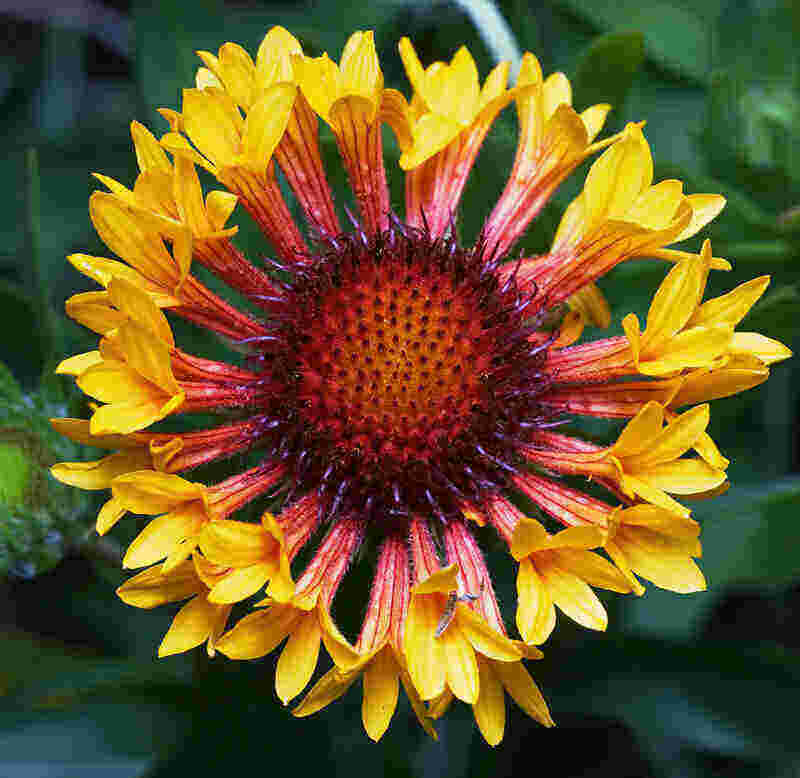
Photo Credit: JJ Harrison / Wikimedia Commons / CC BY-SA 3.0
Gaillardia is a perennial with dark green leaves and bright, daisy-like blooms from summer into late fall. Also known as firewheel, or blanket flower, blooms are typically red to orange, attracting butterflies and Miami pollinators. Firewheel reseeds itself and grows well in beds and containers. Fresh-cut flowers make great additions to home vases and floral arrangements. Gaillardia tolerates sun, heat, sandy soils, and salt.
Growth habit: Flower
USDA hardiness zone: 2-11
Mature size: 12-24 inches tall
Duration: Perennial
Foliage: Semi-evergreen
Sunlight needs: Full sun to partial shade
Soil preferences: Adaptable; acidic or alkaline soil, sand, or loam
Water needs: Drought-tolerant; may need weekly watering during extreme dry spells
Potential hazards: Non-toxic; no safety hazards
12. Gumbo-Limbo Tree (Bursera simaruba)
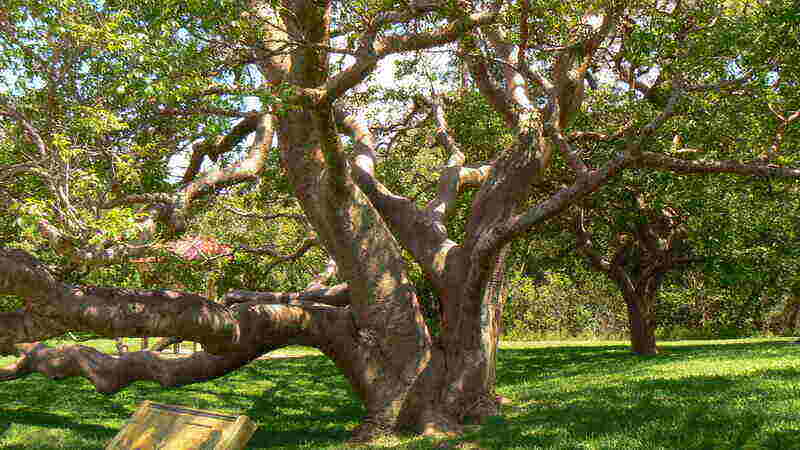
Photo Credit: Milo44 / Wikimedia Commons / CC BY-SA 3.0
A South Florida native, the gumbo-limbo tree is large and semi-evergreen. Mature heights reach up to 60 feet in nature, though they are more compact in home landscaping. They love the tropical Miami climate and make great shade trees.
Gumbo-limbo trees show off bright green leaves with small clusters of light green flowers and peeling copper bark. It is one of the most wind and hurricane-resistant trees in Florida landscaping.
Growth habit: Tree
USDA hardiness zone: 10b-11
Mature size: 25 to 50 feet tall and wide
Duration: Perennial
Foliage: Semi-evergreen
Sunlight needs: Partial shade
Soil preferences: Prefers moist, alkaline soil, sand, loam, or clay
Water needs: Water every seven to 10 days
Potential hazards: Non-toxic; no safety hazards
13. Muhly Grass (Muhlenbergia capillaris)
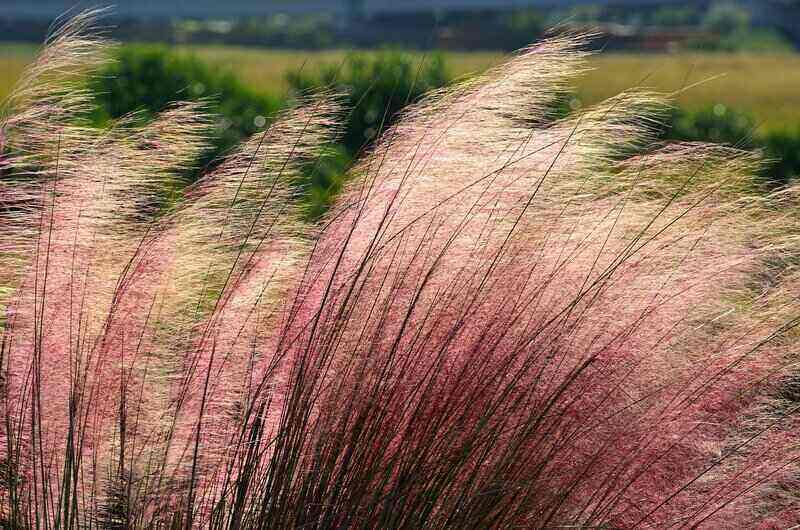
Photo Credit: Pixabay
Muhly grass lines Florida flatwoods, uplands, and highways and makes a popular choice for home landscapes. It is an easy-to-grow ornamental clumping grass that produces fluffy pink flower stalks every fall.
Muhly grass thrives in the Miami sun and is drought-tolerant. The salt-tolerant grass is perfect for coastal areas and grows well in flower beds and along borders.
Growth habit: Ornamental grass
USDA hardiness zone: 7-11
Mature size: 3-5 feet tall and 2-3 feet wide
Duration: Perennial
Foliage: Semi-evergreen
Sunlight needs: Full sun
Soil preferences: Adaptable; acidic or alkaline soil, sand, loam, clay; extended flooding
Water needs: Drought-tolerant; may need weekly watering during extreme dry spells
Potential hazards: Non-toxic; no safety hazards
14. Passion Flower (Passiflora incarnata)
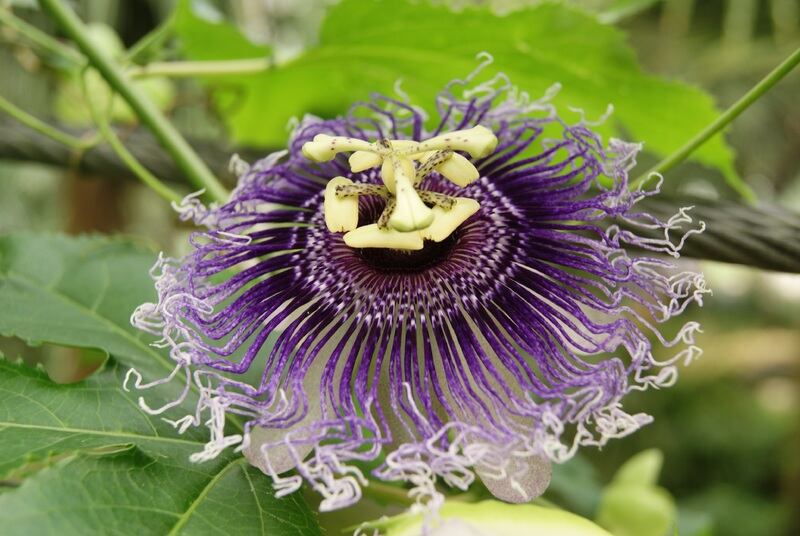
Passion flower, or maypop, is a flowering vine like coral honeysuckle. It is a butterfly host plant, fast-growing, and hardy. Its dense foliage provides natural cover for wildlife while its large lavender blooms attract hummingbirds and butterflies. The vine also produces edible green fruits, though they do not taste good.
Passion flower loves full sun and thrives on a trellis, fence, or archway. It is a spreading vine that will grow to occupy the trellis or fence. They are pest-resistant and tolerate drought conditions. However, the hardy plant is susceptible to nematode damage in South Florida.
Growth habit: Vine
USDA hardiness zone: 6-10
Mature size: Up to 30 feet; spreads to occupy the trellis or fence
Duration: Perennial
Foliage: Evergreen
Sunlight needs: Full sun to partial shade
Soil preferences: Adaptable; prefers moist soil
Water needs: Drought-tolerant; water twice weekly during dry spells
Potential hazards: Non-toxic; safe for humans and animals
15. Scarlet Salvia (Salvia coccinea)
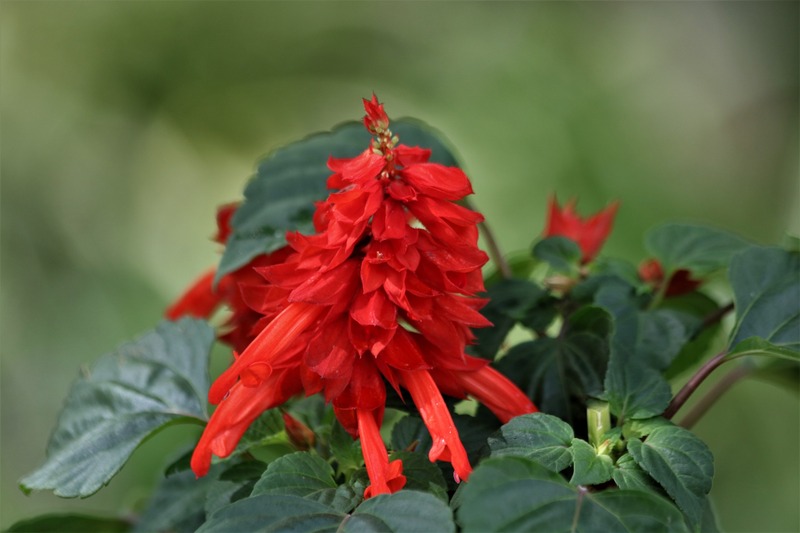
Scarlet salvia goes by many names, including scarlet sage, blood sage, and tropical sage. It is an herbaceous perennial with tubular red flowers that bloom from spring through fall. The attractive plant reaches up to 4 feet tall and attracts Miami wildlife, hummingbirds, and butterflies.
Scarlet salvia is drought and salt-tolerant, tolerating the occasional salty spray well. The adaptable plant responds well to pruning and grows well in flower beds and containers.
Growth habit: Herbaceous plant
USDA hardiness zone: 8-11
Mature size: 2-4 feet tall and 1-2 feet wide
Duration: Perennial
Foliage: Semi-evergreen
Sunlight needs: Full sun
Soil preferences: Adaptable; acidic or alkaline soil, sand, or loam
Water needs: Drought-tolerant; may need weekly watering during extreme dry spells
Potential hazards: Non-toxic; no safety hazards
16. Seagrape (Coccoloba uvifera)
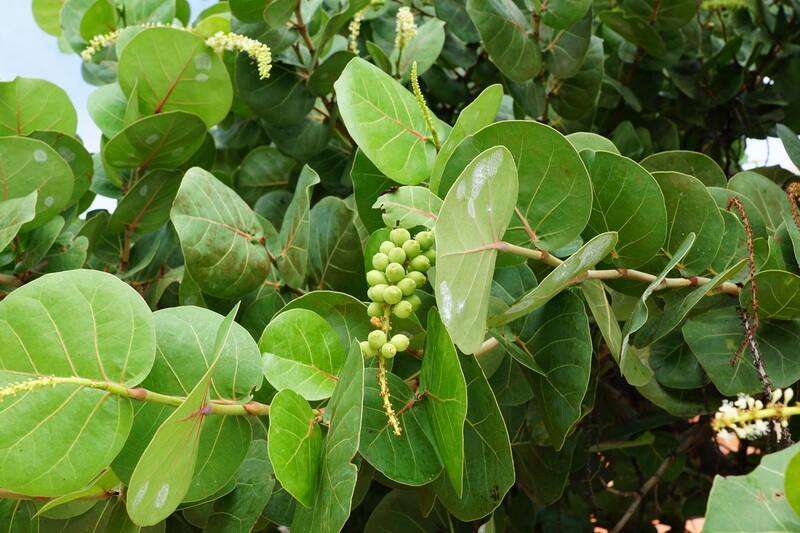
Seagrape is an endangered and protected shrub or tree naturally found growing along the Florida coasts. The salt-tolerant plant produces clusters of edible red fruit resembling grapes, bright-green, round foliage with red veins, and clusters of cream-colored flowers.
Seagrape responds well to pruning, and left unattended, it will grow to 50 feet tall and 30 feet wide. These plants work well as hedges, privacy screens, natural windbreaks, and shade trees. If grown as a tree, an attractive, twisted trunk is visible. Seagrape grows well in full or partial sun and salty acidic soils. It is very low maintenance except for the occasional pruning.
Growth habit: Tree or shrub
USDA hardiness zone: 10A-11
Mature size: 35-50 feet tall and 20-30 feet wide
Duration: Perennial
Foliage: Evergreen
Sunlight needs: Full sun to partial shade
Soil preferences: Adaptable; prefers well-drained soil
Water needs: Drought-tolerant; needs about 1 inch of water per week, including rainfall (may need weekly watering during dry spells
Potential hazards: Non-toxic; edible fruits
17. Star Jasmine (Jasminum nitidum)
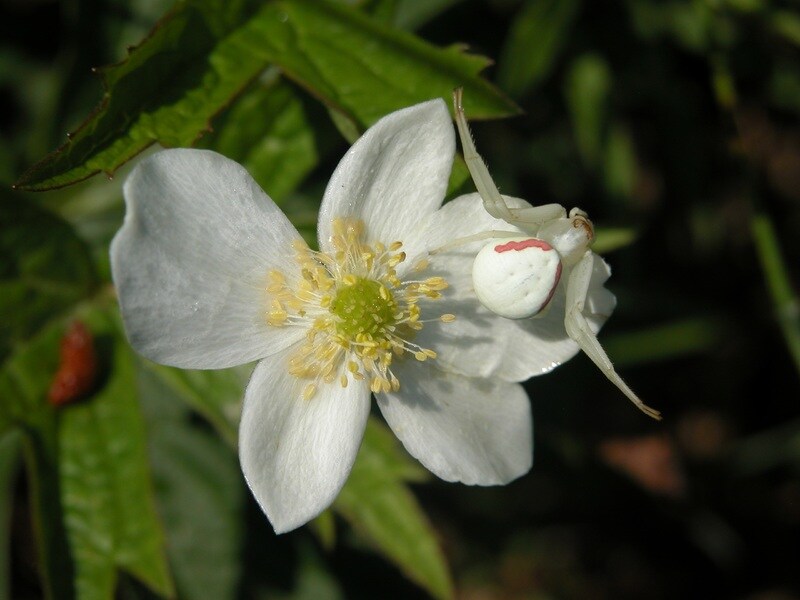
Miami’s tropical climate creates the perfect environment for crawling vines. Star Jasmine, also known as jessamine and evening trumpet flower, is a fragrant flowering vine with clusters of tiny white flowers that bloom in early spring and summer. It is drought resistant and attracts pollinators to your garden. The vine is also moderately salt-tolerant and adapts to shady conditions, making it a great option for coastal landscapes.
This vine is fast-growing, climbing to occupy any available space. It works well as ground cover but requires frequent pruning. Star jasmine is best planted near lampposts, trellises, arbors, or chain-link fences, and will not climb masonry walls or wooden fences without supports.
Growth habit: Vine or spreading groundcover
USDA hardiness zone: 9-11
Mature size: 10-15 feet tall and 3-4 feet wide
Duration: Perennial
Foliage: Evergreen
Sunlight needs: Full sun to partial shade
Soil preferences: Prefers moist, well-drained soil
Water needs: Drought-tolerant; may need weekly watering during extreme dry spells
Potential hazards: Non-toxic; no safety hazards
18. Swamp Mallow (Hibiscus moscheutos)
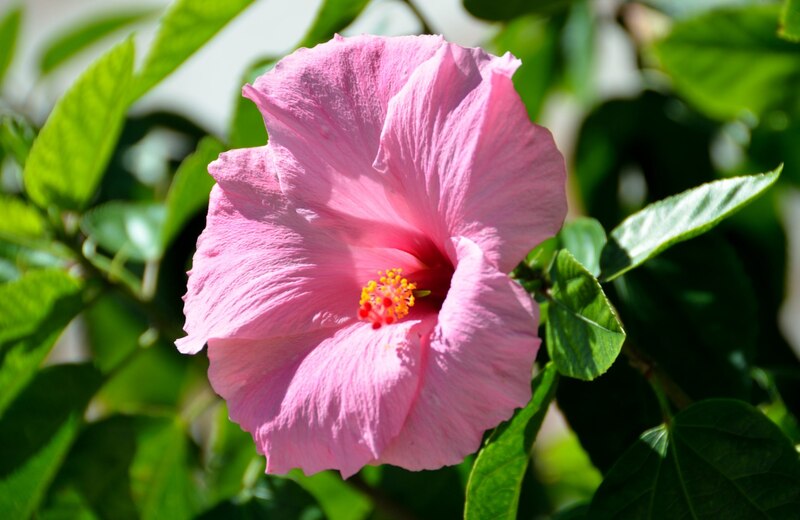
Swamp mallow is a variety of hibiscus with many names in South Florida such as scarlet rosemallow and swamp hibiscus. Like all hibiscus flowers, swamp mallow is an herbaceous perennial with large red flowers that bloom from mid to late summer. The woody plant loves heat, humidity, and wet soil, and is moderately salt-tolerant.
Swamp mallow grows naturally in the Florida wetlands but tolerates drier soil. It loves full sun and can reach heights up to 8 feet. The swamp mallow makes a great informal privacy screen or standalone plant, and the bright blooms will attract butterflies such as Cloudless Sulfurs and Gulf Fritillaries to your Miami yard.
Growth habit: Shrub
USDA hardiness zone: 6-11
Mature size: 4-8 feet tall and 2-4 feet wide
Duration: Perennial
Foliage: Evergreen
Sunlight needs: Full sun to partial shade
Soil preferences: Prefers rich, moist soil
Water needs: Water twice per week
Potential hazards: Non-toxic; no safety hazards
19. Walter’s Viburnum (Viburnum obovatum)
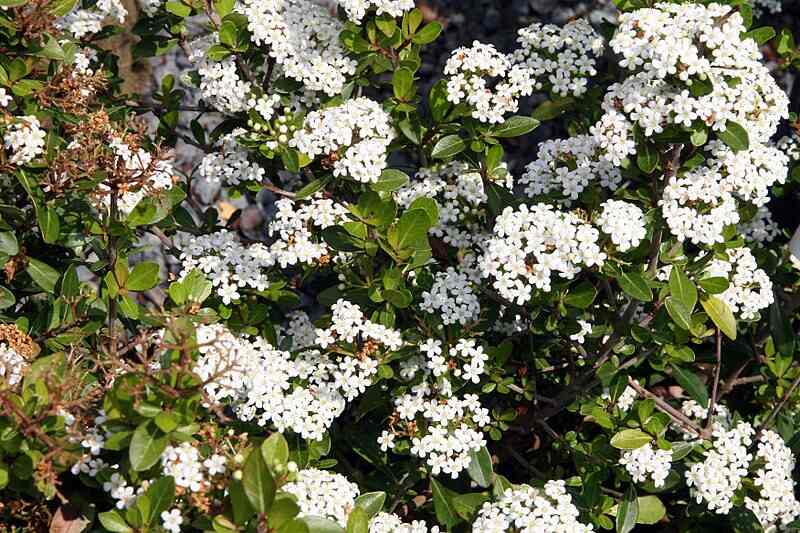
Walter’s viburnum is a large shrub or small tree with small white flowers that attracts butterflies. Fruits of the tree ripen in fall, attracting birds and other wildlife. It can reach up to 20 feet tall but responds well to pruning and training and makes a great hedgerow or privacy screen.
Walter’s viburnum has dense foliage that acts as a nesting spot for songbirds, and it is the host plant for the Azure butterfly. The shrubs prefer full sun to partial shade and are drought-tolerant. However, these plants do not tolerate salt and need moist, well-drained soil.
Growth habit: Tree or shrub
USDA hardiness zone: 7-10
Mature size: 10-20 feet tall and 10-15 feet wide
Duration: Perennial
Foliage: Evergreen
Sunlight needs: Full sun to partial shade
Soil preferences: Prefers well-drained, moist soil
Water needs: Drought-tolerant; water twice weekly
Potential hazards: Non-toxic; safe for humans and animals
20. Wild Coffee (Psychotria nervosa)
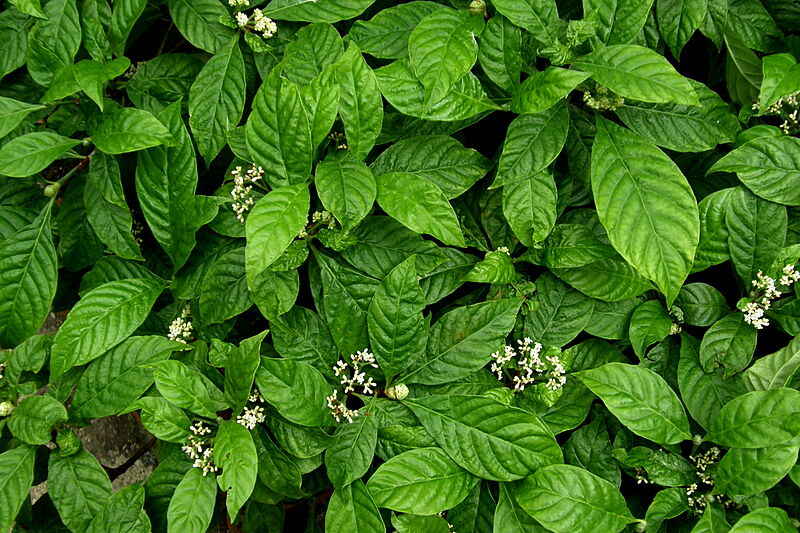
Wild coffee produces shiny, bright-green leaves with clusters of small white flowers in the spring and summer. Red fruits bloom in the summer resembling coffee berries but contain no caffeine. The evergreen shrub’s elongated leaves and dense growth habit make a great hedgerow or border plant for South Florida lawns.
Wild coffee serves as the backbone for the life cycle of the rare Atala butterfly, providing a much-needed nectar source for the insect, while its fruits attract birds and other wildlife. The perennial shrub grows well in partial to full shade and loves well-drained soil. It responds well to pruning and is salt-tolerant.
Growth habit: Shrub
USDA hardiness zone: 9-11
Mature size: 4-10 feet tall and 4-8 feet wide
Duration: Perennial
Foliage: Evergreen
Sunlight needs: Partial shade to full shade
Soil preferences: Adaptable; prefers well-drained soil and does not tolerate heavy clay soil
Water needs: Drought-tolerant; prefers to dry out between waterings
Potential hazards: Moderate toxicity; poisonous to humans and animals
How to Choose Native Plants for Your Miami Yard
Native plants each have their own needs, and not all native plants will grow well in your Miami yard. It is important to consider soil type and proximity to saltwater sprays when selecting plants for your landscape. Select plants suitable for your soil, sun exposure, and watering capabilities.
Miami sits in USDA Hardiness Zones 10 and 11, indicating the coldest annual temperature is between 30 to 35 degrees Fahrenheit. Florida-native plants are cold-hardy to the minimum temperature in Miami’s’ hardiness zones. Keep your zone in mind when selecting non-native plants for your landscape.
FAQ About Native Miami Plants
Thanks to Miami’s year-round tropical climate, you can plant anytime you want. Plants grow faster in the spring and summer, and experts agree the best time to head into your garden is from mid-March to the beginning of April.
Foliage needs time to dry before nightfall, and wet foliage can lead to disease and rot. Early morning or evening are the best times to water your native plants. Winds are calmer and temperatures are lower, so there is less risk of water loss from evaporation or scorching from the sun.
Native plants support the Florida ecosystem and beneficial insects like butterflies, bees, and birds. Many are salt and drought-tolerant and adapted to the acidic, sandy soil found in most South Florida yards, making them easier to grow and more beneficial to the local environment.
Where to Find Native Plants in Miami
Create your own landscape melting pot and invite beautiful blooms, butterflies, and songbirds into your yard. If you want to introduce more native plants into your Miami oasis, source your plants ethically from reputable nurseries.
Check out these local Miami nurseries recommended by the Dade Chapter of the Florida Native Plant Society:
- Alexander Landscaping & Plant Farm
- Citizens For a Better South Florida
- Native Tree Nursery
- Verber’s Jungle Garden
Many native plants are salt and wind-tolerant, standing up to occasional flooding and high winds. Be sure to consider other hurricane-resistant landscaping ideas to complement your new native plants and check out the best grass types for Miami for a healthy lawn.
When you are ready to turn over lawn upkeep to a professional, let Wikilawn connect you with a local landscaping pro in your area.
Main Image Credit: Pxhere